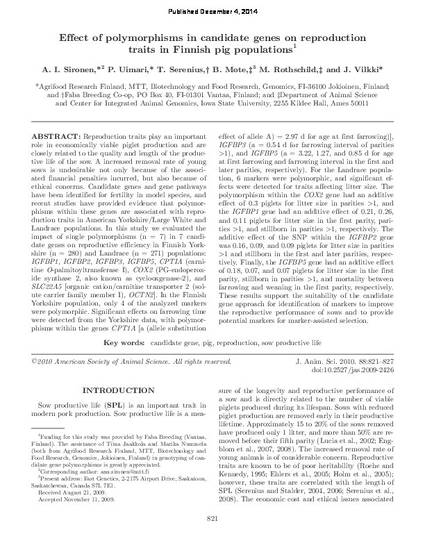
Reproduction traits play an important role in economically viable piglet production and are closely related to the quality and length of the productive life of the sow. A increased removal rate of young sows is undesirable not only because of the associated financial penalties incurred, but also because of ethical concerns. Candidate genes and gene pathways have been identified for fertility in model species, and recent studies have provided evidence that polymorphisms within these genes are associated with reproduction traits in American Yorkshire/Large White and Landrace populations. In this study we evaluated the impact of single polymorphisms (n = 7) in 7 candidate genes on reproductive efficiency in Finnish Yorkshire (n = 280) and Landrace (n = 271) populations: IGFBP1, IGFBP2, IGFBP3, IGFBP5, CPTIA (carnitine O-palmitoyltransferase I), COX2 (PG-endoperoxide synthase 2, also known as cyclooxygenase-2), and SLC22A5 [organic cation/carnitine transporter 2 (solute carrier family member I), OCTN2]. In the Finnish Yorkshire population, only 4 of the analyzed markers were polymorphic. Significant effects on farrowing time were detected from the Yorkshire data, with polymorphisms within the genes CPT1A [a (allele substitution effect of allele A) = 2.97 d for age at first farrowing)], IGFBP3 (a = 0.54 d for farrowing interval of parities >1), and IGFBP5 (a = 3.22, 1.27, and 0.85 d for age at first farrowing and farrowing interval in the first and later parities, respectively). For the Landrace population, 6 markers were polymorphic, and significant effects were detected for traits affecting litter size. The polymorphism within the COX2 gene had an additive effect of 0.3 piglets for litter size in parities >1, and the IGFBP1 gene had an additive effect of 0.21, 0.26, and 0.11 piglets for litter size in the first parity, parities >1, and stillborn in parities >1, respectively. The additive effect of the SNP within the IGFBP2 gene was 0.16, 0.09, and 0.09 piglets for litter size in parities >1 and stillborn in the first and later parities, respectively. Finally, the IGFBP5 gene had an additive effect of 0.18, 0.07, and 0.07 piglets for litter size in the first parity, stillborn in parities >1, and mortality between farrowing and weaning in the first parity, respectively. These results support the suitability of the candidate gene approach for identification of markers to improve the reproductive performance of sows and to provide potential markers for marker-assisted selection.
Available at: http://works.bepress.com/max-rothschild/41/

This is an article from Journal of Animal Science 88 (2010): 821, doi:10.2527/jas.2009-2426. Posted with permission.